Indicator-Based Assessment of Resilience and Vulnerability in the Indian Himalayan Region: A Case Study on Socio-Economy under Different Scenarios
Abstract
1. Introduction
2. Study Area
3. Methodology
4. Results
4.1. Demography
4.2. Household-level Resilience
4.3. Village-level Vulnerability
5. Discussion
6. Conclusions
Supplementary Materials
Author Contributions
Funding
Acknowledgments
Conflicts of Interest
References
- Bolin, B. The Kyoto negotiations on climate change: A scientific perspective. Science 1998, 279, 330–331. [Google Scholar] [CrossRef]
- Wigley, T.M.L.; Richels, R.; Edmonds, J.A. Economic and environmental choices in the stabilization of atmospheric CO2 concentrations. Nature 1996, 379, 240–243. [Google Scholar] [CrossRef]
- Fussel, H.M.; Klein, J.T.R. Climate change vulnerability assessments: An evolution of conceptual thinking. Clim. Chang. 2006, 75, 301–329. [Google Scholar] [CrossRef]
- Rajesh, S.; Jain, S.; Sharma, P.; Bhahuguna, R. Assessment of inherent vulnerability of rural communities to environmental hazards in Kimsar region of Uttarakhand, India. Environ. Dev. 2014, 12, 16–36. [Google Scholar] [CrossRef]
- Summary for Policymakers. Climate Change 2014: Impacts, Adaptation, and Vulnerability. WGII, Fifth Assessment Report (AR5). 2014. Available online: http://ipcc-wg2.gov/AR5/images/uploads/IPCC_WG2AR5_SPM_Approved.pdf (accessed on 28 April 2014).
- Bohle, H.G.; Downing, E.T.; Watts, M.J. Climate change and social vulnerability Toward a sociology and geography of food insecurity. Global Environmental change-human and policy dimensions. Glob. Environ. Chang. 1994, 4, 37–48. [Google Scholar] [CrossRef]
- Adger, W.N. Social aspects of adaptive capacity. In Climate Change, Adaptive Capacity and Development; Smith, J.B., Klein, R.J.T., Huq, S., Eds.; Imperial College Press: London, UK, 2003. [Google Scholar]
- Dev, S.M. Climate Change, Rural Livelihoods and Agriculture (Focus on Food Security) in Asia-Pacific Region. Indira Gandhi Institute of Development Research: Mumbai, India, 2011. Available online: http://www.igidr.ac.in/pdf/publication/WP-2011-014.pdf (accessed on 22 May 2013).
- Magrath, J.; Bray, I.; Scriven, K. Climate Alarm, Disasters Increase as Climate Change Bites. From Weather Alert to Climate Alarm; Oxfam Briefing Paper; Oxfam International: Oxford, UK, 2007. [Google Scholar]
- Goswami, B.N.; Venugopal, V.; Sengupta, D.; Madhusoodanan, M.S.; Xavier, P.K. Increasing trend of extreme rain events over India in a warming environment. Science 2006, 314, 1442–1445. [Google Scholar] [CrossRef]
- Kumar, A. Demystifying a Himalayan tragedy: Study of 2013 Uttarakhand disaster. J. Indian Res. 2013, 1, 106–116. [Google Scholar]
- Sharma, M.; Mishra, S.K.; Tyagi, S. The Impact of Torrential Rainfall in Kedarnath, Uttarakhand, India during June, 2013. Int. Res. J. Environ. Sci. 2013, 2, 34–37. [Google Scholar]
- Watts, M.; Bohle, H.G. The space of vulnerability. The causal structure of hunger and famine. Prog. Hum. Geogr. 1993, 17, 43–67. [Google Scholar] [CrossRef]
- Nelson, D.R.; Adger, W.N.; Brown, K. Adaptation to Environmental Change: Contributions of a Resilience Framework (PDF). Annu. Rev. Env. Resour. 2007, 32, 395–419. [Google Scholar] [CrossRef]
- Folke, C. Resilience: The emergence of a perspective for social-ecological systems analyses. Glob. Environ. Chang. 2006, 16, 253–267. [Google Scholar] [CrossRef]
- Lundberg, M.; Wuermli, A. Children and Youth in Crisis: Protecting and Promoting Human Development in Times of Economic Shocks; World Bank: Washington, DC, USA, 2012. [Google Scholar] [CrossRef]
- Sen, A.K. Development as Freedom; Oxford University Press: Oxford, UK, 1999. [Google Scholar]
- FAO. Climate Change and Food Security: A Framework Document; Food and Agriculture Organisation of United Nations: Rome, Italy, 2008. [Google Scholar]
- Karfakis, P.; Velazco, J.; Moreno, E.; Covarrubias, K. Impact of Increasing Prices of Agricultural Commodities on Poverty; ESA Working Paper Series, No. 2011b; FAO: Rome, Italy, 2011; pp. 11–14. [Google Scholar] [CrossRef]
- Skoufias, E.; Quisumbing, A.R. Consumption Insurance and Vulnerability to Poverty: A Synthesis of the Evidence from Bangladesh, Ethiopia, Mali, Mexico and Russia. Eur. J. Dev. Res. 2005, 17, 24–58. [Google Scholar] [CrossRef]
- Sen, A.K. Poverty and Famines: An Essay on Entitlement and Deprivation; Clarendon: Oxford, UK, 1981. [Google Scholar]
- Adger, W.N. Social vulnerability to climate change and extremes in coastal Vietnam. World Dev. 1999, 27, 249–269. [Google Scholar] [CrossRef]
- Hewitt, K. Regions of Risk: A Geographical Introduction to Disasters; Longman: Harlow, UK, 1997. [Google Scholar]
- Hewitt, K. Interpretations of Calamity from the Viewpoint of Human Ecology; Allen and Unwin: Boston, MA, USA, 1983. [Google Scholar]
- Ribot, J.C.; Magalhães, A.R.; Panagides, S.S. Climate Variability, Climate Change and Social Vulnerability in the Semi-Arid Tropics; Cambridge University Press: Cambridge, UK, 1996. [Google Scholar]
- Smit, B.; Wandel, J. Adaptation, adaptive capacity and vulnerability. Glob. Environ. Chang. 2006, 16, 282–292. [Google Scholar] [CrossRef]
- Van der Veen, A.; Logtmeijer, C. Economic hotspots: Visualizing vulnerability to flooding. Nat. Hazards 2005, 36, 65–80. [Google Scholar] [CrossRef]
- Brooks, N.; Adger, W.N.; Kelly, P.M. The determinants of vulnerability and adaptive capacity at the national level and the implications for adaptation. Global Environ. Chang. 2005, 15, 151–163. [Google Scholar] [CrossRef]
- Adger, W.N.; Brooks, N.; Bentham, G.; Agnew, M.; Eriksen, S. New Indicators of Vulnerability and Adaptive Capacity; Technical Report 7, Tyndall Centre for Climate Change Research; University of East Anglia: Norwich, UK, 2004. [Google Scholar]
- Kelly, P.M.; Adger, W.N. Theory and practice in assessing vulnerability to climate change and facilitating adaptation. Clim. Chang. 2000, 47, 325–352. [Google Scholar] [CrossRef]
- Armaş, I.; Gavriş, A. Census-based social vulnerability assessment for Bucharest. Procedia Environ. Sci. 2016, 32, 138–146. [Google Scholar] [CrossRef]
- Dunning, C.M.; Durden, S.E. Social Vulnerability Analysis: A Comparison of Tools; Institute for Water Resources, 2013. Available online: http://www.iwr.usace.army.mil/docs/iwrreports/2011-R-07.pdf (accessed on 17 July 2020).
- Tapsell, S.; McCarthy, S.; Faulkner, H.; Alexander, M. Social Vulnerability to Natural Hazards; State of the art report from CapHaz-Net’s WP4: London, UK, 2010. [Google Scholar]
- Schmidtlein, M.C.; Deutsch, R.C.; Piegorsch, W.W.; Cutter, S.L. A sensitivity analysis of the social vulnerability index. Risk Anal. 2008, 28, 1099–1114. [Google Scholar] [CrossRef]
- Rygel, L.; O’sullivan, D.; Yarnal, B. A method for constructing a social vulnerability index: An application to hurricane storm surges in a developed country. Mitig. Adapt. Strateg. Glob. Chang. 2006, 11, 741–764. [Google Scholar] [CrossRef]
- Vincent, K. Creating an index of social vulnerability to climate change for Africa. Tyndall Cent. Clim. Chang. Res. Work. Pap. 2004, 56, 41. [Google Scholar]
- Cutter, S.; Boruff, B.J.; Shirley, W.L. Social vulnerability to environmental hazards. Soc. Sci. Quart. 2003, 84, 242–261. [Google Scholar] [CrossRef]
- Pandey, R.; Jha, S. Climate vulnerability index-measure of climate change vulnerability to communities: A case of rural Lower Himalaya, India. In Mitigation and Adaptation Strategies for Global Change; Springer: Berlin/Heidelberg, Germany, 2012; Volume 17, pp. 487–506. [Google Scholar]
- Smit, B.; Pilifosova, O. Adaptation to climate change in the context of sustainable development and equity. In Climate Change Impacts, Adaptation and Vulnerability; IPCC Working Group II, McCarthy, J.J., Canziani, O., Leary, N.A., Dokken, D.J., White, K.S., Eds.; Cambridge University Press: Cambridge, UK, 2001; pp. 877–912. [Google Scholar]
- Legese, S.A.; Olutayo, O.A.; Sulaiman, H.; Rao, P. Assessing climate change impacts in the Lake Tana Sub-Basin, Ethiopia using livelihood vulnerability approach. J. Earth Sci. Clim. Chang. 2016, 7, 368. [Google Scholar] [CrossRef]
- Can, N.D.; Tu, V.H.; Hoanh, C.T. Application of livelihood vulnerability index to assess risks from flood vulnerability and climate variability-A case study in the Mekong Delta of Vietnam. J. Environ. Sci. Eng. 2013, A2, 476. [Google Scholar]
- Hahn, B.M.; Riederer, A.M.; Foster, S.O. The livelihood vulnerability index: A pragmatic approach to assessing risks from climate variability and change—A case study in Mozambique. Glob. Environ. Chang. 2009, 19, 74–88. [Google Scholar] [CrossRef]
- Cariolle, J. The Economic Vulnerability Index; FERDI Working Paper: Clermont-Ferrand, France, 2011. [Google Scholar]
- Gerlitz, J.Y.; Macchi, M.; Brooks, N.; Pandey, R.; Banerjee, S.; Jha, S.K. The Multidimensional Livelihood Vulnerability Index–An instrument to measure livelihood vulnerability to change in the Hindu Kush Himalayas. Clim. Dev. 2017, 9, 124–140. [Google Scholar] [CrossRef]
- Urothody, A.A.; Larsen, H.O. Measuring climate change vulnerability: A comparison of two indexes. Banko Janakari 2010, 20, 9–16. [Google Scholar] [CrossRef]
- Cutter, S.L.; Finch, C. Temporal and spatial changes in social vulnerability to natural hazards. Proc. Natl. Acad. Sci. USA 2008, 7, 2301–2306. [Google Scholar] [CrossRef]
- Reed, M.S.; Podesta, G.; Fazey, I.; Geeson, N.; Hessel, R.; Hubacek, K.; Ritsema, C. Combining analytical frameworks to assess livelihood vulnerability to climate change and analyse adaptation options. Ecol. Econ. 2013, 94, 66–77. [Google Scholar] [CrossRef]
- Car, E.R. Between structure and agency: Livelihoods and adaptation in Ghana’s Central Region. Glob. Environ. Chang. Hum. Policy Dimens. 2008, 18, 689–699. [Google Scholar] [CrossRef]
- Ge, Y.; Dou, W.; Liu, N. Planning Resilient and Sustainable Cities: Identifying and Targeting Social Vulnerability to Climate Change. Sustainability 2017, 9, 1394. [Google Scholar] [CrossRef]
- Nguyen, T.T.X.; Bonetti, J.; Rogers, K.; Woodroffe, C.D. Indicator-based assessment of climate-change impacts on coasts: A review of concepts, methodological approaches and vulnerability indices. Ocean Coast. Manag. 2016, 123, 18–43. [Google Scholar] [CrossRef]
- Singh, S.R.; Eghdami, M.R.; Singh, S. The Concept of Social Vulnerability: A Review from Disasters Perspectives. Int. J. Interdiscip. Multidiscip. Stud. (IJIMS) 2014, 1, 71–82. [Google Scholar]
- Yoon, D.K. Assessment of social vulnerability to natural disasters: A comparative study. Nat. Hazards 2012, 63, 823–843. [Google Scholar] [CrossRef]
- Vincent, K. Uncertainty in adaptive capacity and the importance of scale. Glob. Environ. Chang. 2007, 17, 12–24. [Google Scholar] [CrossRef]
- Niles, M.T.; Salerno, J.D. A cross country analysis of climate shocks and smallholder food insecurity. PLoS ONE 2018, 13, e0192928. [Google Scholar] [CrossRef] [PubMed]
- Rodgers, W.A.; Panwar, H.S.; Mathur, V.B. Wildlife Protected Area Network in India: A Review; Wildlife Institute of India: Dehradun, India, 2000; p. 44.
- Lawrence, M.; Holzmann, P.; O’Donnell, M.; Adams, L.; Holt, J.; Hammond, L.; Duffield, A. The Practitioners’ Guide to the Household Economy Approach. In Save the Children; Boudreau, T., Ed.; Save the Children: London, UK, 2008. [Google Scholar]
- Challinor, A.J.; Watson, J.; Lobell, D.B.; Howden, S.M.; Smith, D.R.; Chhetri, N. A meta-analysis of crop yield under climate change and adaptation. Nat. Clim. Chang. 2014, 4, 287. [Google Scholar] [CrossRef]
- Bi, D.; Dix, M.; Marsland, S.J.; O’Farrell, S.; Rashid, H.; Uotila, P.; Hirst, A.; Kowalczyk, E.; Golebebiewski, M.; Sullivan, A.; et al. The ACCESS coupled model: Description, control climate and evaluation. Aust. Meteorol. Ocean. J. 2013, 63, 41–64. [Google Scholar] [CrossRef]
- Ahmed, M.; Suphachalasai, S. Assessing the Costs of Climate Change and Adaptation in South Asia; Asian Development Bank: Mandaluyong City, Philippines, 2014. [Google Scholar]
- World Bank. 2009. Available online: http://go.worldbank.org/OJ4FWPUB10 (accessed on 20 December 2017).
- Xu, J.; Badola, R.; Chettri, N.; Chaudhary, R.P.; Zomer, R.; Pokhrel, B.; Hussain, S.A.; Pradhan, S.; Pradhan, R. Sustaining Biodiversity and Ecosystem Services in the Hindu Kush Himalaya. In The Hindu Kush Himalaya Assessment; Wester, P., Mishra, A., Mukherji, A., Shrestha, A., Eds.; Springer: Cham, Switzerland, 2019. [Google Scholar]
- ADB. Building Climate Resilience in the Agriculture Sector in Asia and the Pacific; ADB/International Food Policy Research Institute: Manila, Philippines, 2009. [Google Scholar]
- Nelson, G.C.; Rosegrant, M.W.; Koo, J.; Robertson, R.; Sulser, T.; Zhu, T.; Ringler, C.; Msangi, S.; Palazzo, A.; Batka, M.; et al. Climate Change: Impact on Agriculture and Costs of Adaptation; Food policy reports 21; International Food Policy Research Institute (IFPRI): Washington, DC, USA, 2009. [Google Scholar]
- Singh, P.; Bengtsson, L. Hydrological sensitivity of a large Himalayan basin to climate change. Hydrol. Process 2004, 18, 2363–2385. [Google Scholar] [CrossRef]
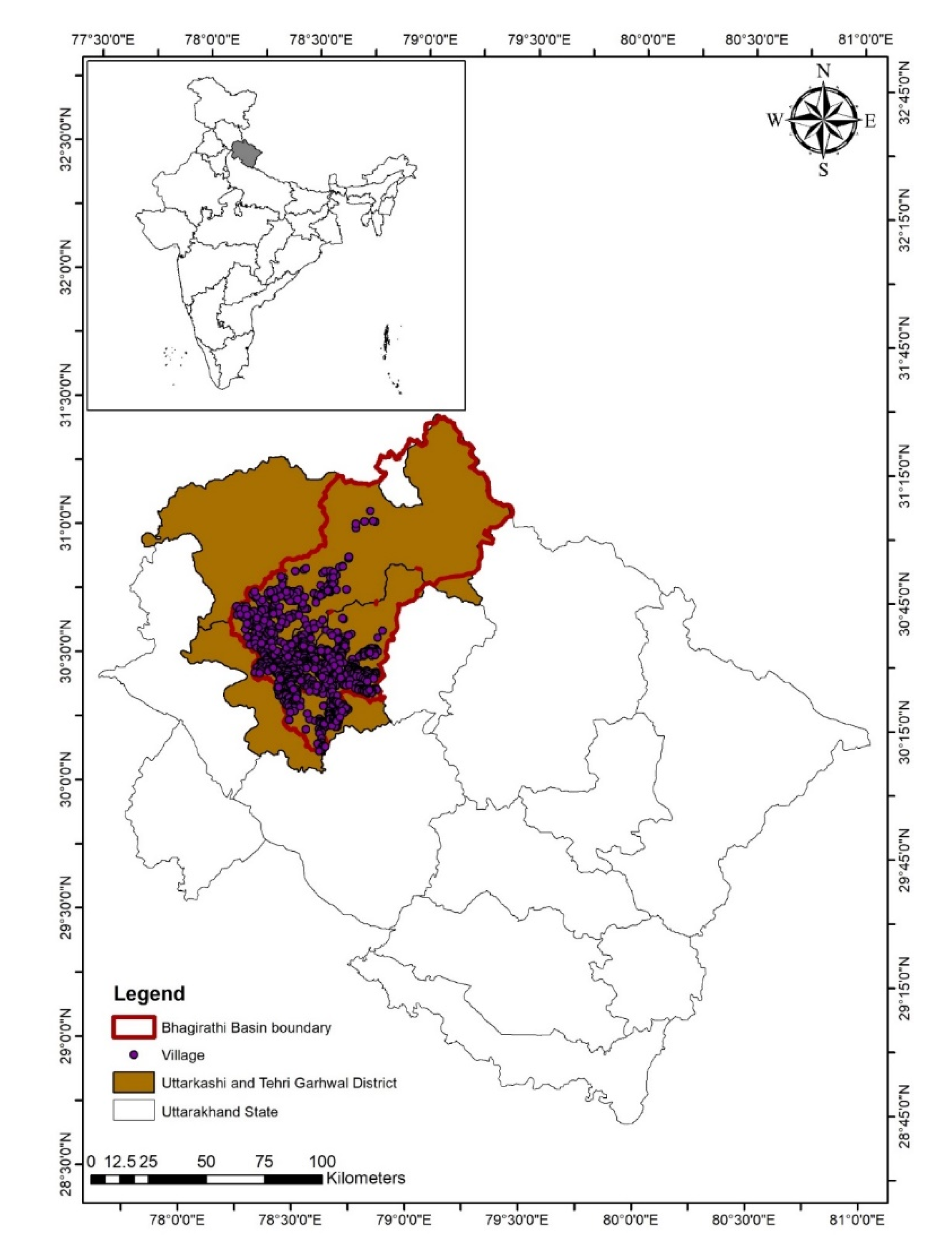
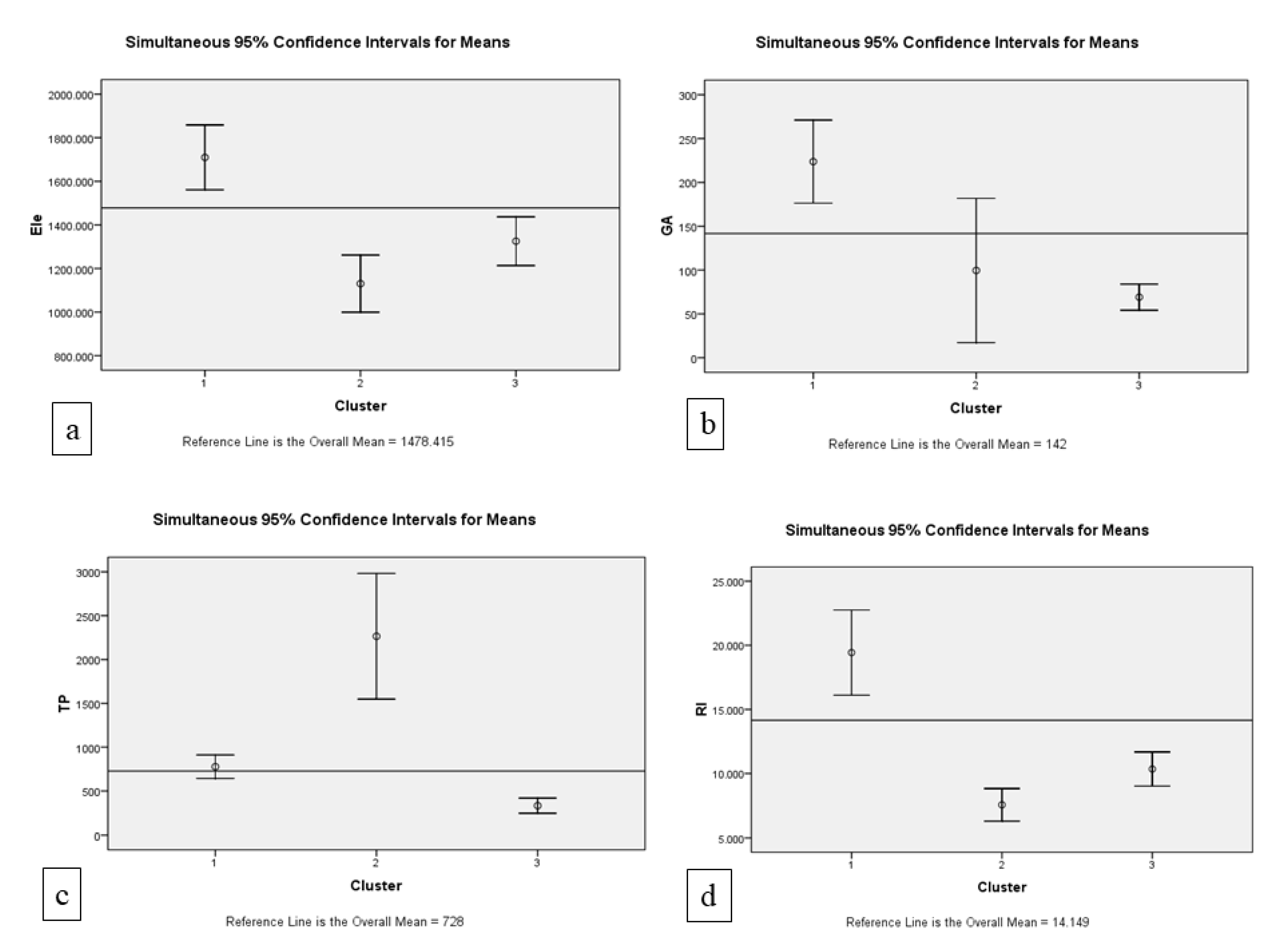
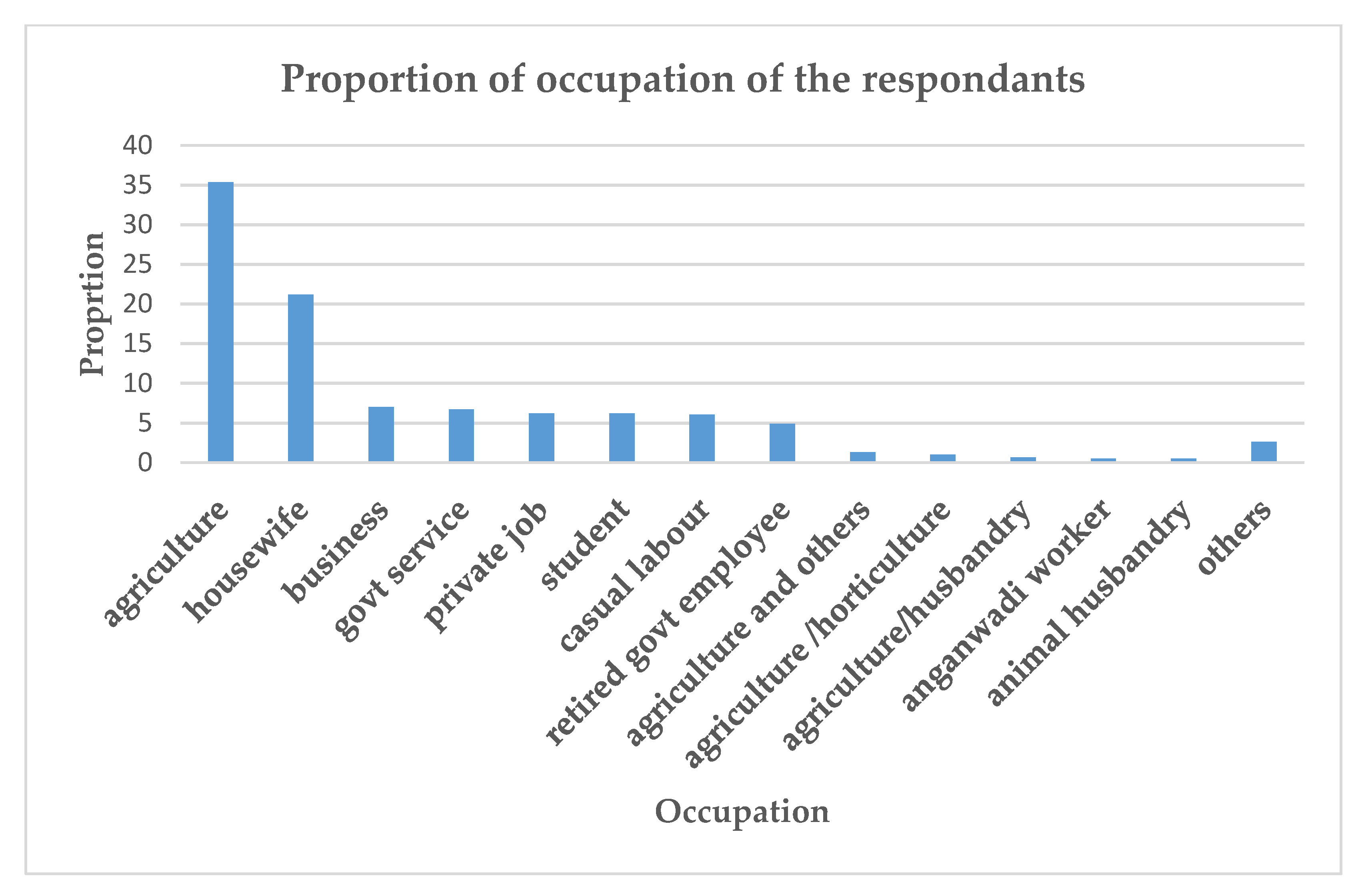
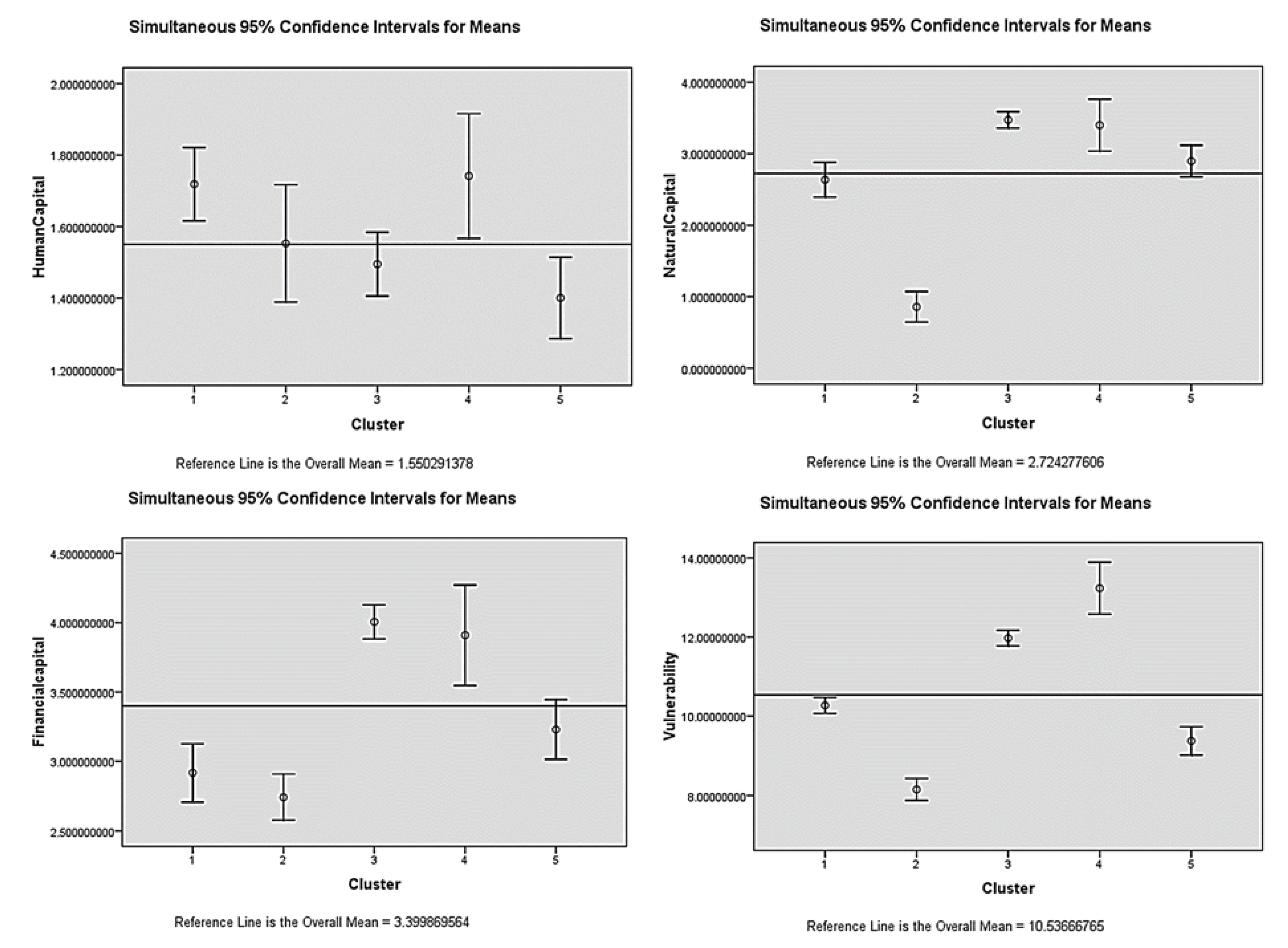
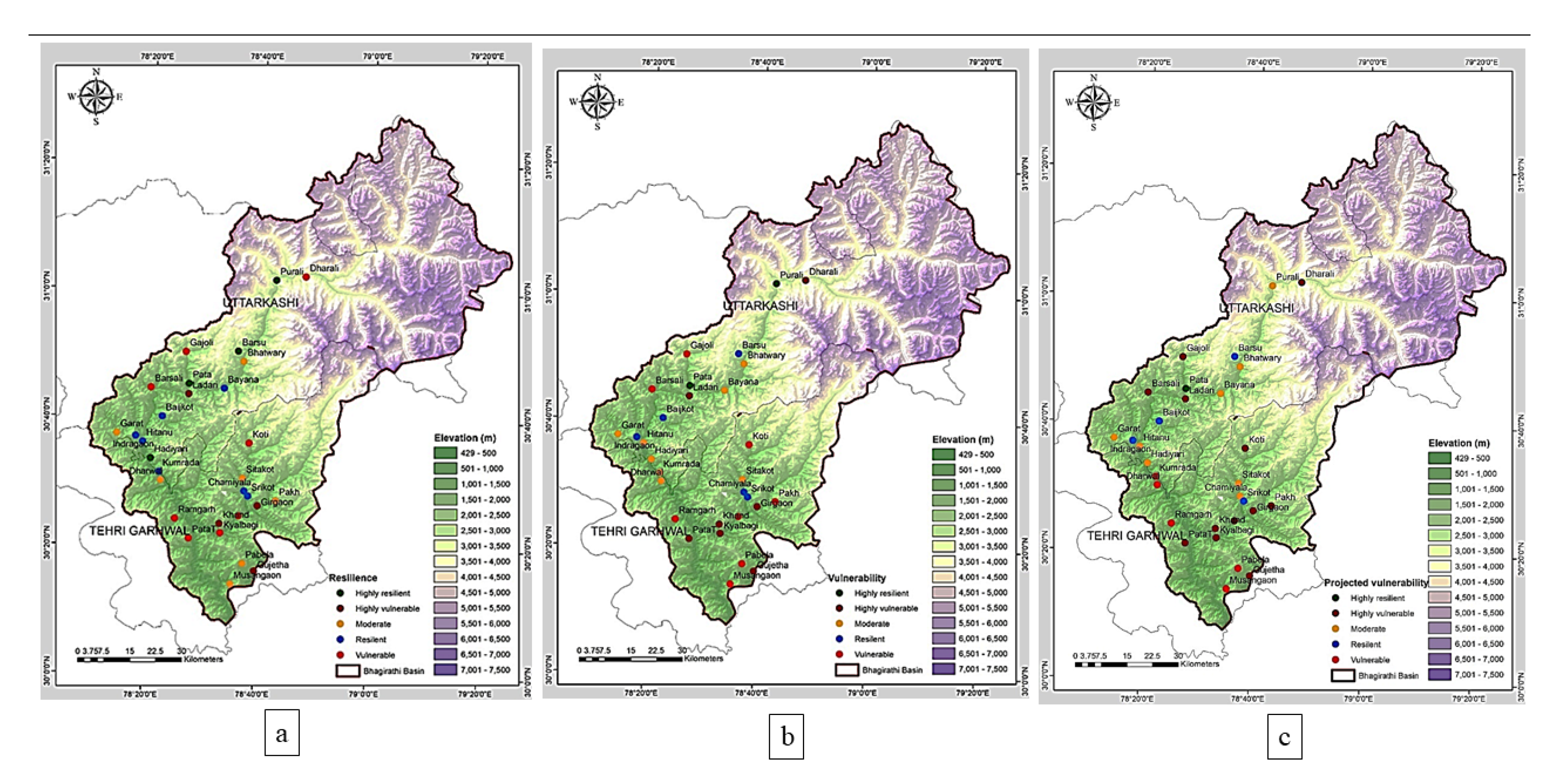
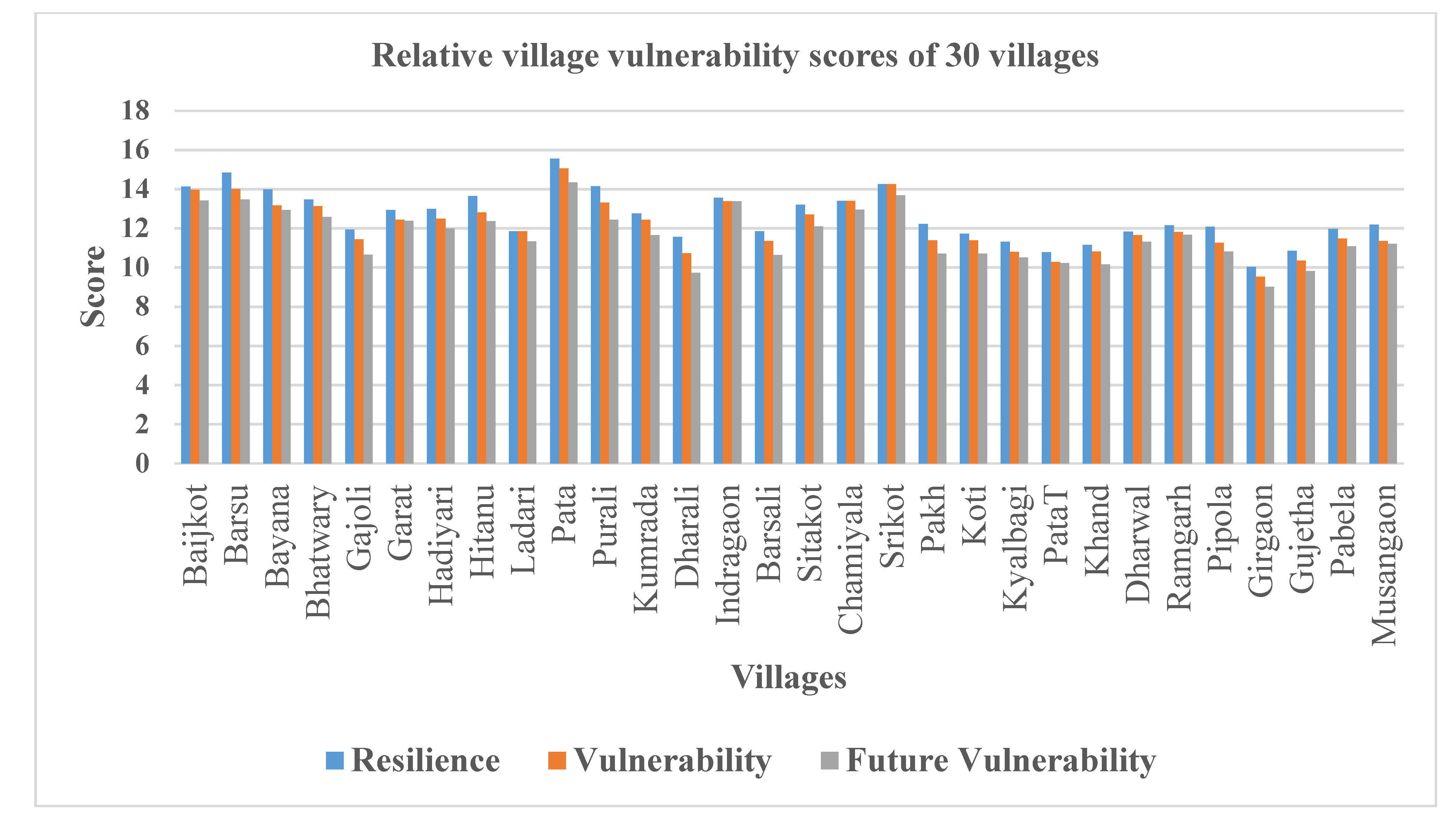
| District | Village | Household Surveyed | Male Respondents (%) | Female Respondents (%) |
|---|---|---|---|---|
| Uttarkashi | Baijkot | 14 | 35.71 | 64.29 |
| Uttarkashi | Barshali/Nakori | 13 | 84.62 | 15.38 |
| Uttarkashi | Barsu | 19 | 36.84 | 63.16 |
| Uttarkashi | Bayana | 18 | 50.00 | 50.00 |
| Uttarkashi | Bhatwari | 23 | 69.57 | 30.43 |
| Tehri Garhwal | Chamiyala | 21 | 42.86 | 57.14 |
| Uttarkashi | Dharali | 22 | 86.36 | 13.64 |
| Tehri Garhwal | Dharwal | 21 | 36.36 | 63.64 |
| Uttarkashi | Gajoli | 28 | 64.29 | 35.71 |
| Uttarkashi | Garat | 13 | 69.23 | 30.77 |
| Tehri Garhwal | Girgaon | 22 | 22.73 | 77.27 |
| Tehri Garhwal | Gujetha | 15 | 53.33 | 46.67 |
| Uttarkashi | Hadiyari | 17 | 64.71 | 35.29 |
| Uttarkashi | Hitanu | 19 | 31.58 | 68.42 |
| Uttarkashi | Indergaao | 9 | 77.78 | 22.22 |
| Tehri Garhwal | Khand | 26 | 76.92 | 23.08 |
| Tehri Garhwal | Koti | 28 | 46.43 | 53.57 |
| Uttarkashi | Kumrada | 43 | 44.19 | 55.81 |
| Tehri Garhwal | Kyal Baghi | 6 | 100.00 | 0.00 |
| Uttarkashi | Ladari | 48 | 51.06 | 48.94 |
| Tehri Garhwal | Musan | 10 | 40.00 | 60.00 |
| Tehri Garhwal | Pabela | 11 | 45.45 | 54.55 |
| Tehri Garhwal | Pakh | 35 | 54.29 | 45.71 |
| Tehri Garhwal | Pata (TG) | 25 | 36.00 | 64.00 |
| Uttarkashi | Pata (U) | 20 | 65.00 | 35.00 |
| Tehri Garhwal | Pipola | 21 | 33.33 | 66.67 |
| Uttarkashi | Purali | 15 | 46.67 | 53.33 |
| Tehri Garhwal | Ramgarh | 21 | 38.10 | 61.90 |
| Tehri Garhwal | Sitakot | 18 | 72.22 | 27.78 |
| Tehri Garhwal | Srikot | 45 | 55.56 | 44.44 |
| Village Level | Data Source | Data Used for Analysis | ||
|---|---|---|---|---|
| No. | Capital | Indicator | ||
| 1 | Physical | Altitude | Google Earth | Ranked |
| 2 | Physical | Disaster risk | Village survey | Ranked |
| 3 | Physical | Agricultural dependency | Village survey | Ranked |
| 4 | Physical | Remoteness | Village survey | Ranked |
| 5 | Physical | Wildlife interaction | Village survey | Ranked |
| 6 | Physical | Water accessibility | Village survey | Ranked |
| 7 | Physical | Total geographic area | Census 2011 | Ranked |
| Household-level | ||||
| 1 | Human | Education | Household-level survey | Ranked |
| 2 | Financial | Occupation | Household-level survey | Ranked |
| 3 | Human | Total members earn | Household-level survey | Number |
| 4 | Human | Number of dependent persons | Household-level survey | Number |
| 5 | Natural | Agricultural area | Household-level survey | Ranked |
| 6 | Financial | Variety of pulses | Household-level survey | Number |
| 7 | Financial | Production of pulses | Household-level survey | Ranked |
| 8 | Financial | Variety of cereals | Household-level survey | Number |
| 9 | Financial | Production of cereals | Household-level survey | Ranked |
| 10 | Financial | Variety of fruits and vegetables | Household-level survey | Number |
| 11 | Financial | Production of fruits and vegetables | Household-level survey | Ranked |
| 12 | Financial | House status (Kaccha/concrete) Wall material and roof material | Household-level survey | Ranked |
| 13 | Physical | Electricity | Household-level survey | Presence/absence |
| 14 | Physical | Running water | Household-level survey | Presence/absence |
| 15 | Physical | LPG connection | Household-level survey | Presence/absence |
| 16 | Physical | Fuel wood | Household-level survey | Presence/absence |
| 17 | Physical | Kerosene | Household-level survey | Presence/absence |
| 18 | Natural | Fodder variety | Household-level survey | Number |
| 19 | Natural | Fodder extraction | Household-level survey | Ranked |
| 20 | Natural | Fuelwood extraction | Household-level survey | Number |
| 21 | Human | Total family member | Household-level survey | number |
| Age Group | 21 to 30 | 31 to 40 | 41 to 50 | 51 to 60 | Above 60 |
|---|---|---|---|---|---|
| 21 to 30 | |||||
| 31 to 40 | 10 (NS) | ||||
| 41 to 50 | 19.5 (NS) | 9.5 (NS) | |||
| 51 to 60 | 18.5 (NS) | 8.5 (NS) | 1 (NS) | ||
| Above 60 | 12 (NS) | 2 (NS) | 7.5 (NS) | 6.5 (NS) | 0.00 |
| Vulnerability Class | Mean | Std Dev | Lower Limit | Upper Limit |
|---|---|---|---|---|
| Highly resilient | 14.378 | 1.089409 | 13.28859 | 15.46741 |
| Resilient | 13.6745 | 0.51129 | 13.16321 | 14.18579 |
| Moderate | 12.589 | 0.645 | 11.944 | 13.234 |
| Vulnerable | 11.664 | 0.455 | 11.209 | 12.119 |
| Highly vulnerable | 10.962 | 0.757 | 10.205 | 11.719 |
| Village | Resilience | Present Vulnerability | Reason | Future Vulnerability | Reason |
|---|---|---|---|---|---|
| Baijkot | resilient | resilient | Less stress for climate related effects | resilient | High natural and financial capital and low dependency on climate sensitive resources |
| Barsu | highly resilient | resilient | high stress for climate related effects | resilient | High physical and financial capital for adaptation to climate stress |
| Bayana | resilient | moderate | high stress for climate related effects | moderate | High financial capital and less dependency on climate sensitive resources |
| Bhatwary | moderate | moderate | Moderate to less stress for climate related effects | moderate | High physical capital and support due to block and circle headquarter |
| Gajoli | vulnerable | vulnerable | Moderate to less stress for climate related effects | highly vulnerable | high dependency on agriculture and low financial capital |
| Garat | moderate | moderate | Moderate to less stress for climate related effects | moderate | High human capital and less dependency on climate sensitive resources |
| Hadiyari | highly resilient | moderate | High dependency on natural capital and low financial capital to cope up with | moderate | Less dependency on climate sensitive resources |
| Hitanu | resilient | moderate | high stress for climate related effects | moderate | Less dependency on agriculture |
| Ladari | highly vulnerable | highly vulnerable | Less stress for climate related effects | highly vulnerable | Less dependency on agriculture |
| Pata | highly resilient | highly resilient | Moderate to less stress for climate related effects | highly resilient | High physical and financial capital to cope up with the stress |
| Purali | highly resilient | highly resilient | high stress for climate related effects | moderate | High dependency on climate sensitive resources and natural capital |
| Kumrada | resilient | moderate | Low physical capital and medium effect of climate stress | vulnerable | Low physical capital and medium effect of climate stress |
| Dharali | vulnerable | highly vulnerable | Low financial capital and high stress for climate related effects | highly vulnerable | High dependency on climate sensitive resources and less financial capital to cope up with stress |
| Indragaon | resilient | resilient | Less stress for climate related effects | resilient | Less stress for climate related effects |
| Barsali | vulnerable | vulnerable | Moderate to less stress for climate related effects | highly vulnerable | Low human capital and dependency on climate sensitive resources |
| Sitakot | moderate | moderate | Moderate to less stress for climate related effects | moderate | Moderate to less stress for climate related effects |
| Chamiyala | resilient | resilient | moderate stress for climate related effects | moderate | Low natural capital and high agricultural dependency |
| Srikot | resilient | resilient | Less stress for climate related effects | resilient | Less stress for climate related effects |
| Pakh | moderate | vulnerable | high stress for climate related effects | highly vulnerable | High dependency on climate sensitive resources |
| Koti | vulnerable | vulnerable | Moderate to less stress for climate related effects | highly vulnerable | Low financial capital and high dependency on climate sensitive resources |
| Kyalbagi | vulnerable | highly vulnerable | Low financial capital and moderate stress of climate change | highly vulnerable | Low financial capital and moderate stress of climate change |
| PataT | vulnerable | highly vulnerable | high stress for climate related effects | highly vulnerable | high stress for climate related effects |
| Khand | highly vulnerable | highly vulnerable | Moderate to less stress for climate related effects | highly vulnerable | Moderate to less stress for climate related effects |
| Dharwal | moderate | moderate | Less stress for climate related effects | vulnerable | High dependency on climate sensitive resources |
| Ramgarh | vulnerable | vulnerable | Moderate to less stress for climate related effects | vulnerable | Moderate to less stress for climate related effects |
| Pipola | vulnerable | vulnerable | high stress for climate related effects | highly vulnerable | Low human capital and high dependency on climate sensitive resources |
| Girgaon | highly vulnerable | highly vulnerable | Moderate to less stress for climate related effects | highly vulnerable | Moderate to less stress for climate related effects |
| Gujetha | highly vulnerable | highly vulnerable | Moderate to less stress for climate related effects | highly vulnerable | Moderate to less stress for climate related effects |
| Pabela | moderate | vulnerable | high stress for climate related effects | vulnerable | high stress for climate related effects |
| Musangaon | moderate | vulnerable | high stress for climate related effects | vulnerable | high stress for climate related effects |
© 2020 by the authors. Licensee MDPI, Basel, Switzerland. This article is an open access article distributed under the terms and conditions of the Creative Commons Attribution (CC BY) license (http://creativecommons.org/licenses/by/4.0/).
Share and Cite
Dasgupta, S.; Badola, R. Indicator-Based Assessment of Resilience and Vulnerability in the Indian Himalayan Region: A Case Study on Socio-Economy under Different Scenarios. Sustainability 2020, 12, 6938. https://doi.org/10.3390/su12176938
Dasgupta S, Badola R. Indicator-Based Assessment of Resilience and Vulnerability in the Indian Himalayan Region: A Case Study on Socio-Economy under Different Scenarios. Sustainability. 2020; 12(17):6938. https://doi.org/10.3390/su12176938
Chicago/Turabian StyleDasgupta, Soumya, and Ruchi Badola. 2020. "Indicator-Based Assessment of Resilience and Vulnerability in the Indian Himalayan Region: A Case Study on Socio-Economy under Different Scenarios" Sustainability 12, no. 17: 6938. https://doi.org/10.3390/su12176938
APA StyleDasgupta, S., & Badola, R. (2020). Indicator-Based Assessment of Resilience and Vulnerability in the Indian Himalayan Region: A Case Study on Socio-Economy under Different Scenarios. Sustainability, 12(17), 6938. https://doi.org/10.3390/su12176938




